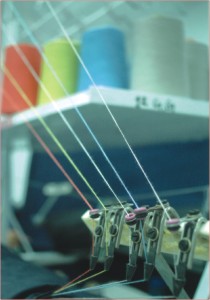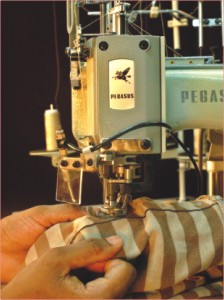
Inside
|
Rags to riches…what next?
There has possibly been nothing more spectacular in Bangladesh than the growth of the readymade garment export. From a base of $600 million in 1990, exports of RMG reached $7.9 billion in 200506. The RMG sector has created job opportunities for millions. Along with the accessories sector, it now provides direct employment for over 2 million workers, of whom 80 percent are women. A further, 8-10 million more Bangladeshis depend indirectly on the RMG sector for their livelihood. It has also emerged as the main source for the foreign exchange required to finance import of capital goods, industrial raw materials and consumer products. Nevertheless, the RMG industry in Bangladesh has developed in an environment of restrictions imposed by developed countries, particularly the US and the EU, on import of textiles and apparels from major developing countries such as South Korea, Taiwan, China, the Philippines, and our South Asian neighbours.
In the beginning Hundreds of factories rapidly dotted Dhaka and Chittagong, mostly in hired premises, as many young and energetic entrepreneurs, though inexperienced, ventured into this promising trade. Meanwhile, the "demand pull" of the US and European shoppers for inexpensive clothing further paved the way for the growth of the RMG sector in Bangladesh. The first challenge came in 1984, however, when the US served a "call notice" to impose quotas, alleging market disruption from an import surge of woven shirts from Bangladesh. Many factories went out of business. The US proposed a liberal "global quota" on exports of all categories of apparels and textiles. Bangladesh, however, opted for a restrictive quota on shirts only, and kept the door open for export of other categories. Garment manufacturers took this opportunity to diversify production. The US imposed quota restrictions on about 30 more categories, as exports to the US increased till the Uruguay Round WTO Agreement on Textiles and Clothing became effective in January 1995. Facing restrictions in the US, some manufacturers started exporting to Europe. European countries also imposed quotas, but withdrew the restrictions once imports started showing downward trend. Successive governments supported RMG export with facilities like bank credit at reduced rates of interest, duty free import of machinery, cash subsidy, and exemption from value-added and other taxes. The country's remarkable macro-stability since 1990, despite its turbulent political culture of hartals and blockades, steered the sector's uninterrupted growth. In addition to quota-protected export markets, Bangladesh's RMG industry benefited from tariff concessions granted under the EU's Generalised System of Preference (GSP) and more recently under its Everything But Arms initiative for Least Developed Countries. However, for duty-free access to the EU markets, apparels produced in a LDC must fulfill its GSP Rules of Origin, which require that a two-stage transformation must take place within its territory. For woven garments this means that the fabrics used in production should be locally produced, while for knitwear products the used yarn should be of domestic origin. Fortunately, almost all Bangladeshi exporters of knitwear, and a significant portion of woven garments, succeeded in meeting those criteria. Export performance since the MFA phase-out However, against all grim predictions, Bangladesh has so far fared well. Data compiled by the Export Promotion Bureau show that in the fiscal year 2003-2004 export earnings from RMG stood at $7.6 billion, while, in 2004-05, which included the first six months of the quota-free regime, exports rose by more than $1 billion, registering a growth of about 19 percent. The growth rate in 2005-06 was an even more impressive 23.5%. The growth trend of the last fiscal year was also encouraging. During June 2006-January 2007, exports of woven garments and knitwear were, respectively, $2,698.50 and $2,636.87 million compared to the previous year's corresponding period's $2,262.54 and $2,086.23 million, registering an increase of 27.80 and 27.84 percent respectively. Emerging successfully Second, with the phasing out of MFA and gradual integration of trade in textiles and clothing in the GATT regime many exporters came out of the "demand pull" scenario and embarked on a campaign of "supply push" in the global marketplace. The tariff concessions that the EU and Canada granted to LDCs were particularly helpful. A depreciating taka enabled them to offer more competitive prices. Third, in the apprehension of possible annihilation in global competition, exporters modernised their supply chain management using ITC and other modern management tools and also adopted more advanced technology and production techniques to increase productivity in their factories. Productivity also increased as the workers' skills improved, in most cases through "learning by doing." Last but not the least, workers fearful of losing jobs worked very hard and fully cooperated with the factory management by working late hours, and sometimes seven days a week. The way ahead The safeguard measures taken against China benefited other Asian suppliers, particularly Bangladesh. The EPB's data did not reveal the worrying fact that during the first year of quota phase out Bangladesh's exports to the EU actually declined from 3.9 billion Euro to 3.7 billion, i.e. a growth rate of minus 5.1 percent. Bangladesh staged a strong recovery, posting a growth rate of 38 percent, during January-July 2006. Restricted supplies from China and the resultant rising prices possibly contributed, to a large extent, to this encouraging development.
Another cause for concern for Bangladesh is the relatively weak growth performance of woven garment export. The recent export growth in RMG has principally been driven by knitwear products. Historically, the US has been the main market for woven garments, and the EU a destination for knit products. After the quota phase out, there have been an enlarged exporting opportunities for knitwear in the US, along with an expansion in woven garments in both the markets. However, EU imports of woven garments from Bangladesh declined by about 12 percent in 2005. However, the situation improved last year. Most woven garments made in Bangladesh have low domestic value added content, and, therefore, do not qualify for EU GSP facilities. According to one estimate, Europe is the destination of about 35 percent of Bangladesh's woven exports, of which only 40 percent receive GSP benefits. A significant proportion of Bangladesh's apparel exports to the EU are subject to the MFN duty, which is averaged around 12 percent. Before phase out of the MFA, it was thought that Bangladesh would not have any problem in the EU market because of the GSP tariff preference. However, failure to satisfy EU rules of origin made a large proportion of woven garments ineligible for DF entry. Another factor that contributed positively to Bangladesh's export competitiveness is the depreciation of its currency. Bangladesh maintained a managed exchange rate regime for more than 20 years, and then embarked on a freely floating exchange rate system in May 2003. Though the taka remained stable initially for a year and a half, it experienced significant depreciation. The depreciation of the taka coincided with the phasing out of the MFA regime. A comparison of nominal exchange rates of several Asian currencies vis-à-vis US dollar shows that only Bangladesh taka depreciated, particularly during 2004-06. The Chinese yuan and Indian rupee had somewhat appreciated during the same period. Even after adjusting for the changes in domestic price levels, it was observed that the real exchange rates of taka vis-à-vis all these currencies depreciated significantly since the MFA phase-out. The considerable depreciation of the Taka in the post-MFA period, and the restraints on Chinese exports by the EU and the US, has either enhanced or at least protected the international competitiveness of Bangladesh exports and thus helped it in enlarging its share of global apparel trade. Bangladesh will face the real test of its RMG sector's export competitiveness in January 2009, when EU and US safeguard measures on imports from China expire. For surviving and thriving in the forthcoming intense global competition, Bangladesh has to raise productivity in its textile and apparel sectors by adopting advanced production and management methods and technologies, developing skills of its workforce, and improving labour-management relations. Simultaneously, the government should create a hassle-free business environment and reduce cost of doing business by removing administrative bottlenecks; improving the functioning of infrastructural facilities -- telecommunication network, ports, road, rail and waterways; ensuring uninterrupted and adequate supplies of electricity, gas and water; raising the efficiency of the country's financial sector and ensuring rule of law and macro-economic stability. Further, if DFQF market access for Bangladesh products including RMG can be attained in the markets abroad, particularly in the US and neighbouring India and China within the WTO framework or under any regional trading arrangement, exports will increase at a much higher rate, and the county will move to a higher trajectory of economic development. Photos:MUMIT M |

 The WTO Agreement on Textiles and Clothing saw the elimination of all MFA (Multi-Fibre Arrangement) quotas in four phases over 10 years, beginning from January 1995. Thus, the sector came under the purview of WTO's GATT regime for imports from all member countries since January, 2005. This change in trade rules intensified competition in the global marketplace. Concerns were expressed long before the phase-out of MFA quotas that, despite the projected substantial gains of the world economy as a whole, a number of countries including Bangladesh might lose due to regime change.
The WTO Agreement on Textiles and Clothing saw the elimination of all MFA (Multi-Fibre Arrangement) quotas in four phases over 10 years, beginning from January 1995. Thus, the sector came under the purview of WTO's GATT regime for imports from all member countries since January, 2005. This change in trade rules intensified competition in the global marketplace. Concerns were expressed long before the phase-out of MFA quotas that, despite the projected substantial gains of the world economy as a whole, a number of countries including Bangladesh might lose due to regime change.  Other exporters, such as Cambodia, India, Indonesia, the Philippines, Sri Lanka, and Vietnam also attained high rates of export growth. In the case of the US also, after the imposition of restrictions in the latter half of 2005, China's export growth in 2006 somewhat stagnated, while imports from Bangladesh and others recorded high growth.
Other exporters, such as Cambodia, India, Indonesia, the Philippines, Sri Lanka, and Vietnam also attained high rates of export growth. In the case of the US also, after the imposition of restrictions in the latter half of 2005, China's export growth in 2006 somewhat stagnated, while imports from Bangladesh and others recorded high growth.